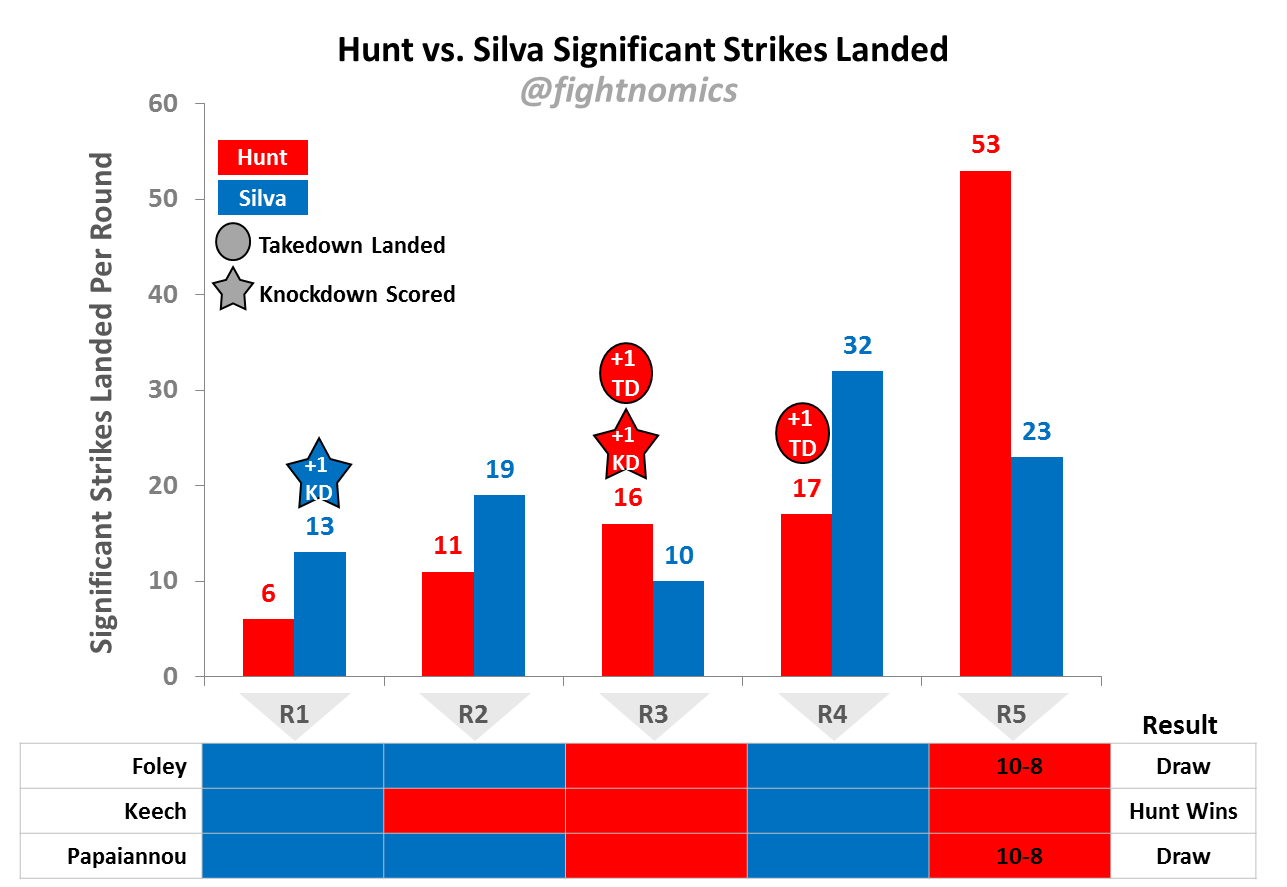Fight Stats Rewind: Hunt Versus Silva Round-by-Round Scoring
The main event of UFC Fight Night 33 from Brisbane Australia was not supposed to last long. Mark Hunt and Antonio “Bigfoot” Silva each have a tendency to leave the cage with their shield or on it, rarely requiring the services of the judges at cage side. According to moneyline odds, the market wasn’t expecting this fight to go the distance. Actually, the market believed that more likely than not, the fight wouldn’t even last 1.5 rounds. But somehow these two men managed to keep fighting the full 25 minutes, turning in an instant classic, a potential fight of the year winner, and a performance that truly defied the odds. Draws have only occurred in 0.6% of UFC fights since 2001, and never in a heavyweight matchup. In fact, Cain Velasquez and Junior dos Santos are the only other active heavyweights to have fought five rounds in a fight, something they did in 2012, and had not occurred prior since the 2007 heavyweight title fight between Randy Couture and Tim Sylvia. So it’s worth a closer look to see how this happened. In order for a UFC fight to be scored a draw, one of two scenarios must occur. First, in an otherwise split fight one round must be scored evenly as a 10-10, which occurs very infrequently in less than 1% of all UFC fights. Or second, there must be a reduced round awarded to a fighter that was otherwise going to edge out a one-round victory. This reduced round could be due to a penalty deduction, or from losing a 10-8 round. In any of these scenarios the single round that is scored something other than 10-9 must be accompanied by other rounds that are relatively evenly split between the two fighters. It was the latter of the two scenarios that caused the fight between Mark Hunt and Antonio Silva to be scored a draw. The chart below shows Significant Strikes Landed by round, and aligns the scoring of each of the three judges to each round. Successful takedowns (“TD”) and knockdowns (“KD”) are also noted per fighter and round.
The three judges were in agreement for the winners of each round except the second. The second round, without any takedowns landed or knockdowns scored, was also the most even according to the statistics. In terms of significant strikes attempted, the two fighters were almost identical with their volume of output, but Silva was the more effective in landing his shots. Arguably, Silva look staggered after one big shot from Hunt at one point, so disagreement over this round is understandable. And back-and-forth they went. As the fight wore on, both combatants actually picked up the pace of their striking, despite looking increasingly exhausted. Perhaps even more amazingly, both fighters scored knockdowns and Silva looked wobbled at multiple points, and yet neither succumbed nor was able to finish the other. By the final frame Hunt was landing just about everything he threw at Silva, unfortunately for him he just didn’t have as much power in his strikes at that point. And that’s where things get really interesting on the scorecards. The final round was clearly won by Hunt, but to what extent? Two out of three judges (Foley and Papaiannou) gave Hunt a 10-8 round, while Keech awarded a 10-9 score favoring Hunt. Historically, 10-8 rounds occur about 6% of the time in fights that go the distance. In boxing, a knockdown scored in a round automatically results in a reduced score for the round loser, but in this fight neither fighter earned a 10-8 score for the round in which they scored their knockdown. Instead it was the final round when Hunt stalked forward and landed punches to Silva’s head nearly at will that led the judges to give a special score favoring Hunt. Were it not for that decision by two judges in the final round, the fight would not have been a draw. Think about that, both judges Foley and Papaiannou were looking at awarding the final round to Hunt, but determining Silva to be the winner if a 10-9 score was used. Neither did this. Meanwhile, Judge Keech had already awarded enough rounds to Hunt for the win, and so the 10-8 score might have seemed a little gratuitous in his final score for the fight. In all cases the final round score changed the winner of the fight. Had only one of the two judges using a 10-8 score decided against it, the fight would also have been a draw, and had they both used 10-9 scores Silva would have won. Was Silva truly dominated in round five, more so than either fighter was in prior rounds? Or could the judges in after the final round have looked at their cards and realized that a 10-8 score would lead to a more justice-serving end result? It’s also interesting to note that if this had been a three-round fight, then Silva would have taken the split decision, but fans would have been robbed of some of the most exciting moments in heavyweight history. Any way you slice this, the fight was epic and statistically anomalous, with heavyweights going the distance, 10-8 rounds, knockdowns from both fighters, and round five output from Hunt that many would have thought impossible from a heavyweight. It’s no surprise that UFC boss Dana White responded to the fight on Twitter by suggesting he should buy these two fighters their own islands.
